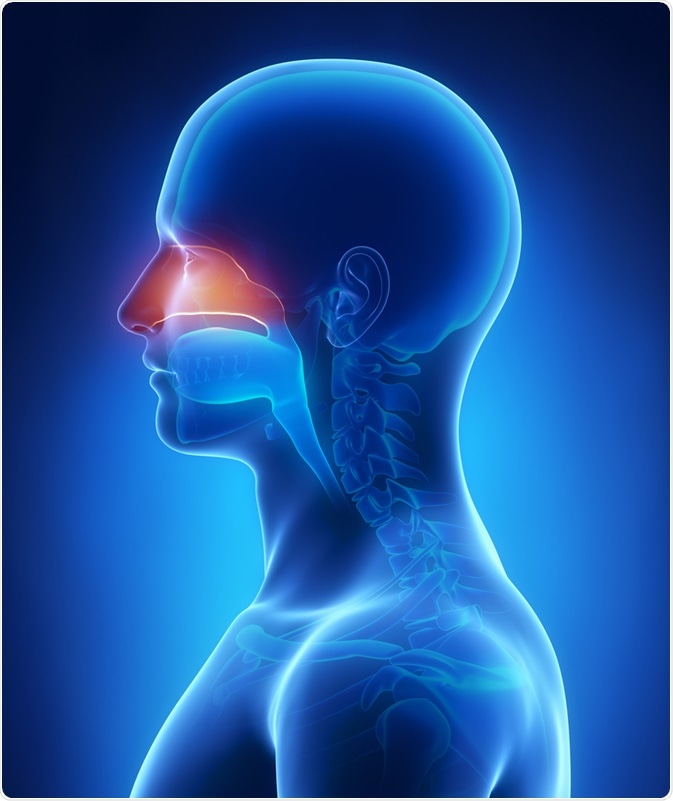Rhinitis, the inflammation of the nasal cavity lining, can cause a significant impact on the quality of life. Treatment tends to be expensive to the health care system, and the estimations in 2002 were that allergic rhinitis alone accounted for 11 billion American dollars in direct and indirect medical costs. If we include non-allergic rhinitides into the picture, that number continues to grow.

Image Credit: CLIPAREA l Custom media/Shutterstock.com
The additional problem is misdiagnosing and mismanaging this condition by primary care providers, costing much more to the system in lost days of work for ineffective treatment and continued discomfort to the patient. Therefore it is of uttermost importance to address and treat these patients properly in order to decrease the associated costs.
Optimal management of rhinitis should include a multifaceted approach with reliance on patient education, environmental control and trigger avoidance, pharmacotherapy, and (in appropriately selected cases) subcutaneous immunotherapy. The general approach to non-allergic rhinitis is to find and treat any underlying conditions that may be contributing to the clinical presentation.
Pharmacological therapy
According to the guidelines, oral antihistamines are generally considered first-line therapy for allergic rhinitis which relieves sneezing, itching, and watery nose and eyes. Their topical administration can further minimize systemic adverse effects of antihistamines, and they can be combined with a decongestant to reach sufficient efficacy for nasal congestion.
The majority of research studies favor the use of intranasal corticosteroids, as they treat inflammatory conditions regardless of etiology. There is ample evidence that corticosteroids benefit allergic rhinitis, some forms of non-allergic rhinitis (including vasomotor rhinitis), as well as chronic rhinosinusitis.
Ipratropium bromide represents a potent intranasal anticholinergic with efficacy in the treatment of isolated anterior rhinorrhea in both allergic and non-allergic rhinitides alike. It has also been proven to be safe and effective when combined with a corticosteroid or some sort of antihistamine drug.
Capsaicin, a pungent component of hot pepper, is a blocking agent of neuropeptides which can block the axon reflex and may exert a curative effect on allergic rhinitis. This treatment modality may also be the first step to more specific treatment options for patients with idiopathic rhinitis unresponsive to standard treatment regimens.
Cromoglycate is quite beneficial in the management of seasonal and perennial allergic rhinitis. Decongestants can reduce nasal obstruction and congestion by their vasoconstrictive action on alpha-adrenergic receptors, but their intranasal application can result in rhinitis medicamentosa.
Other treatment modalities
Different non-pharmacologic measures should deserve consideration in the treatment of rhinitis. Allergen avoidance can reduce acute exacerbations and lessen the likelihood of a priming effect in patients with allergic rhinitis, but this approach is only suitable after specific allergens have been identified via skin or radioallergosorbent testing.
Allergen immunotherapy involves the subcutaneous application of gradually increasing quantities of the patient’s relevant allergens until an effective dose that induces immunologic tolerance is reached. Albeit this form of therapy has been shown efficacious for the treatment of allergic rhinitis caused by dust mites and pollens, limited use has been demonstrated in treating animal dander and mold allergies.
One promising and safe therapeutic modality is phototherapy. Accumulating evidence shows that this type of treatment can suppress the effector phase and result in significant improvement of allergic rhinitis. Furthermore, far infrared ray therapy to the nasal region can improve the clinical symptoms of eye and nasal itching, nasal stuffiness, rhinorrhea, and sneezing.
In refractory cases, surgical therapy is also an option for select patients with rhinitis, polyposis, or chronic sinus disease. Most surgical interventions can be executed under local anesthesia in an office or outpatient setting. In conclusion, as there are many therapeutic options, a systematic approach to the rhinitis patient is crucial.
Rhinitis and Its Treatment | Todd Kingdom, MD, Ear, Nose and Throat | UCHealth
References
- http://www.waojournal.org/content/2/3/20
-
Small, P. and Kim, H. (2011) "Allergic rhinitis", Allergy, Asthma & Clinical Immunology, 7(S1). doi: 10.1186/1710-1492-7-s1-s3.
- http://www.aafp.org/afp/2002/1201/p2164.html
-
Plaut, M. and Valentine, M.D. (2005). Allergic Rhinitis. New England Journal of Medicine, 353(18), pp.1934–1944.
-
Nozad, C. et al. (2010) "Non-allergic rhinitis: a case report and review", Clinical and Molecular Allergy, 8(1). doi: 10.1186/1476-7961-8-1.
-
Greiner, A.N. and Meltzer, E.O. (2011). Overview of the Treatment of Allergic Rhinitis and Nonallergic Rhinopathy. Proceedings of the American Thoracic Society, 8(1), pp.121–131.
- Hu KH, Li WT. Phototherapy for the Treatment of Allergic Rhinitis. In: Kowalski ML, ed. Allergic Rhinitis. In Tech, 2012; pp. 183-196.
Further Reading
Last Updated: Aug 17, 2021